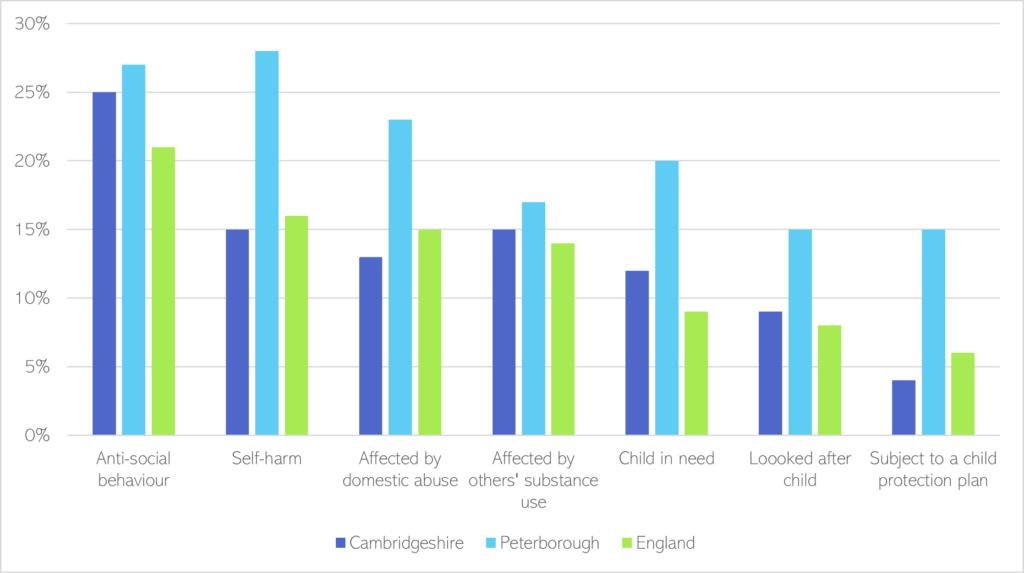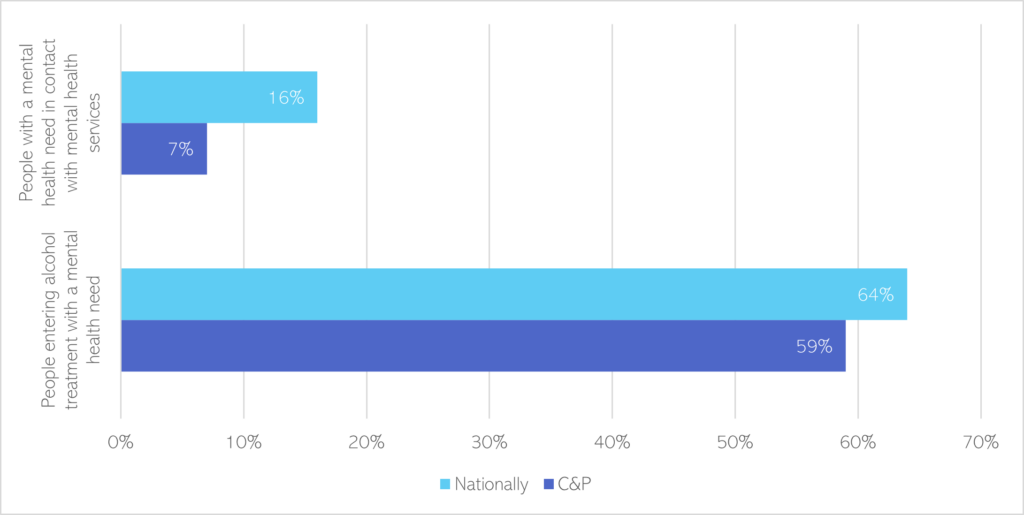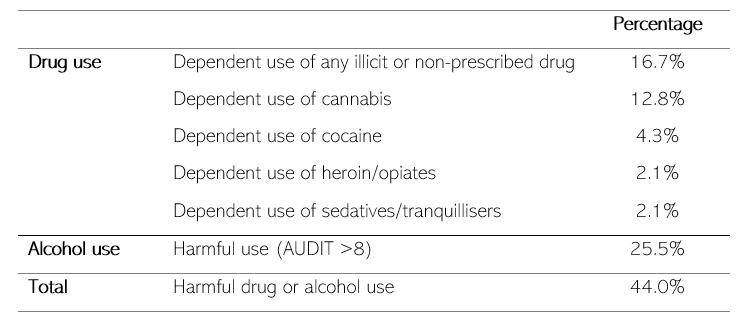Co-occurring conditions
‘Rather than seeing people with dual diagnosis as having two main problems, it may be more useful to acknowledge that they have complex needs including physical health, social issues such as housing, relationship and family problems, risk of suicide victimisation and violence’ (L. Hughes, 2006)
People with co-occurring conditions have co-existing substance use and mental health issues. The term co-occurring condition has been used instead of ‘dual diagnosis’, as people may have multiple mental health conditions or use several substances concurrently; and some may have not received formal diagnoses of these issues. People who have co-occurring conditions are more likely to have multiple needs than those who have either mental health conditions or use substances. These needs include:
- People with co-occurring conditions are more likely to experience:
- Unemployment (V. Crawford et al., 2003).
- Debt (Public Health England, 2019a).
- Housing problems (Public Health England, 2019a) and homelessness (NHS England, 2016a).
- Poor physical health (Public Health England, 2019a).
- Poor diets (NHS England, 2016a).
- Domestic abuse (Humphreys et al., 2005).
- People with co-occurring conditions are more likely to be admitted to hospital, to self-harm, or die by suicide (Public Health England, 2019a).
- People with harmful alcohol use are over 3 times more likely to attempt suicide than those who do not (Darvishi et al., 2015).
- Over half (54%) of people who die by suicide have a history of harmful alcohol and/or drug use (Appleby et al., 1997). Between 2012 and 2014, only 11% of this group were in contact with drug or alcohol services.
- Some evidence suggests that there is a high prevalence of complex trauma (Rieley et al., 2021) and childhood maltreatment (V. Crawford et al., 2003) amongst people with co-occurring conditions.
- Vulnerable subgroups of people with co-occurring conditions include women, older people, and people with SMI (Public Health England, 2017):
- Women have higher rates of co-occurring conditions than men, but present later to drug and alcohol services (V. Crawford et al., 2003).
- Older people with co-occurring conditions are an under-recognised group, which may be more at risk of substance-related harm due the effects of ageing (Crome, 2018).
- People with SMI with substance use are at higher risk of poor physical health, unemployment and homelessness, and exploitation (including sexual exploitation) (Kawecki & Ebert, 2016).
What is the national picture?
- There is a high prevalence of co-occurring conditions in (Public Health England, 2017):
- People in contact with the criminal justice system.
- People presenting to hospital emergency departments in mental health crisis.
- People experiencing severe and multiple disadvantage.
National prevalence of mental health need within drug and alcohol services
- 63% of people starting drug and alcohol treatment in England in 2020/21 had a mental health need, a significant proportion of which had not received any mental health treatment (Office for Health Improvement & Disparities, 2021). Levels of mental health need were highest amongst people who used non-opiate drugs and alcohol.
- One survey of inpatients in substance treatment services found that (Dore et al., 2012):
- 45% had symptoms of PTSD.
- 20% had moderate to severe depressive symptoms.
- 37% had ever self-harmed or attempted suicide.
National prevalence of substance use within mental health services
- Substance use is rarely limited to a single substance, although difference substances are associated with different mental health conditions (V. Crawford et al., 2003).
- It has been estimated that 35 to 50% of people with SMI have problems with substance and/or alcohol use (Megnin-Viggars et al., 2016). For example, approximately 40% of people with psychosis use substances at some point in their lifetime, at least double the rate in the general population (Megnin-Viggars et al., 2016).
What is the local picture?
Among young people (under 18s) in alcohol and drug treatment, there are:
- High rates of self-harm, particularly in Peterborough where rates of self-harm (28%) are substantially higher than the national average (16%).
- High rates of risk factors for poor mental health, including experiences of domestic abuse.

Figure 122: Young people (under 18) in substance use treatment with wider vulnerabilities for Cambridgeshire and Peterborough, and England, 2020-21. Data source: NDTMS
Local prevalence of mental health need within alcohol treatment services
The 2023 Drug and Alcohol Needs Assessment found that there is a high prevalence of mental health need amongst people in in alcohol services: 59% of people entering alcohol treatment have a mental health need (Elvin et al., 2023).

Figure 123: The proportion of people entering alcohol treatment with a mental health need in Cambridgeshire and Peterborough. Data source: (Elvin et al., 2023).
Given that 887 adults in Cambridgeshire, and 376 adults in Peterborough, were in alcohol treatment in 2021/22 (Elvin et al., 2023), the 2003 COSMIC study (Weaver et al., 2003) has been used to estimate that there are at least 1074 people across Cambridgeshire and Peterborough in alcohol treatment who have a diagnosable mental health condition.
- Note this estimate does not include PTSD, which is likely to be highly prevalent in this group (Dore et al., 2012).

Table 37: Predicted numbers of people with mental health conditions amongst those in alcohol treatment in Cambridgeshire and Peterborough in 2021/22. Based on figures from: (Elvin et al., 2023), (Weaver et al., 2003)
A relatively low proportion of adults entering alcohol treatment in Cambridgeshire and Peterborough are already engaged with Community Mental Health Teams or other specialist mental health services, compared to the national average. However, a slightly higher proportion are receiving mental health support from their GP.

Table 38: Proportion of new presentations of adults in alcohol only treatment identified as having a mental health treatment need and receiving treatment for their mental health. Data source: NDTMS
Local prevalence of mental health need within drug treatment services
The 2023 Drug and Alcohol Needs Assessment highlighted high levels of mental health need amongst young people and adults in drug treatment (Elvin et al., 2023):
- Mental health need is particularly high in adult women in drug treatment, of whom 77% in Cambridgeshire and 78% in Peterborough have been identified with a mental health need.
- Young people in drug treatment in Cambridgeshire have higher levels of identified mental health need than young people in Peterborough.

Figure 124: The proportion of people in drug treatment identified with a mental health need across Cambridgeshire, Peterborough and England, by age group and gender. Data source: (Elvin et al., 2023)
Based on the prevalence rates of mental health conditions found in the 2003 COSMIC study (Weaver et al., 2003), and given that there were 1714 adults in Cambridgeshire and 1125 adults in Peterborough in drug treatment in 2021/22 (Elvin et al., 2023), it has been estimated that there are 2129 people in drug treatment who have at least one diagnosable mental health condition.
- Note this estimate does not include PTSD, which is likely to be highly prevalent in this group (Dore et al., 2012).

Table 39: Predicted numbers of people with mental health conditions amongst those in drug treatment in Cambridgeshire and Peterborough in 2021/22. Based on figures from: (Elvin et al., 2023),(Weaver et al., 2003)
Local prevalence of substance use within mental health services
A local audit of Addenbrooke’s Hospital in Cambridge found that (Lam et al., 2022):
- A quarter of emergency department presentations of impulsive suicidal acts, ideation and self-harm were related to alcohol use, yet only half of these patients were offered advice or an intervention about their alcohol use.
- This study led to the liaison staff being trained in brief interventions for alcohol use.
- The 2003 COSMIC study (Weaver et al., 2003) suggests that the following proportion of people in contact with community mental health services are likely to have dependent substance use.

Table 40: Estimated proportion of people in contact with Community Mental Health Services with dependent alcohol and/or drug use Data source: (Weaver et al., 2003)
Additional resources
- The local data pack gives an overview of key data and trends
- Cambridgeshire and Peterborough Drug and Alcohol Needs Assessment 2023
- Cambridgeshire and Peterborough-Drugs and Alcohol Priorities (2022-2027)
- NICE guidelines Coexisting severe mental illness and substance misuse: community health and social care services
- Turning Point’s Dual Diagnosis toolkit
- A literature review of dual diagnosis
- The experiences of local service users, told in their own words
- Facilitators and barriers in dual recovery: A literature review of first-person perspectives
- Stigma Kills | NHS Addictions Provider Alliance
References
Full list of references is included at the end of this chapter.
